Weldability Evaluation of Alloy 718 Investment Castings with Different Si Contents and Thermal Stories and Hot Cracking Mechanism in Their Laser Beam Welds
Abstract
:1. Introduction
2. Materials and Methods
2.1. Investment Casting and Chemical Composition of Alloy 718 Casting Heats
2.2. Weldability Assessment Trials
2.3. Metallographic Characterisation
3. Results
3.1. As-Cast Microstructure
3.2. Microstructure after Heat Treatment and before Welding Trials
3.3. LBW Varestraint Weldability Test Results
3.4. Hot Ductility Weldability Test Results
3.5. Bead-on-Plate Weldability Test Results
3.6. Microstructural Characterisation of Bead-on-Plate Welding Samples
4. Discussion
4.1. Influence of Chemical Composition, Investment Casting Conditions, and Heat Treatment on Microstructure and Weldability
4.2. Correlation between Weldability Assessment Trials
5. Conclusions
- Microstructural analysis of as-cast samples showed differences between heats in terms of amount and chemical composition of Laves phase, grain size, and aspect ratio. Shape of γ grains mainly depended on cooling rate.
- After HIP and solution annealing heat treatment, residual contents (less than 0.35% in area) of Laves phase were only observed in the samples with higher Si content and slower solidification rate, i.e., moulds P, N, and NP. The application of additional pre-HIP cycle to slowly solidified casting at 1052 °C for 2 h was not enough to completely remove the Laves phase.
- Onset of hot ductility drop in on-heating hot ductility test was directly related to the presence of residual Laves phase, whereas the hot ductility recovery behaviour was connected to the Si content and parent material grain size. Coarser grain size was associated with very slow recovery rate and very limited ductility recovery capability due to longer liquid continuity after incipient melting. In parallel, higher Si content reduced DRT and enlarged BTR.
- LBW Varestraint tests gave rise to enhanced fusion zone (FZ) cracking with much reduced heat-affected zone (HAZ) cracking on the surface. Both TCL FZ and TCL HAZ were mostly independent of Si content and presence of residual Laves phase.
- In all LBW welds, Laves phase was formed again in the FZ. The chemical composition of regenerated Laves phase has a composition similar to the eutectic of the pseudo-binary equilibrium diagram of alloy 718, and this suggests a long persistence of terminal liquid during the welding solidification. FZ Laves phase had eutectic morpho-logy.
- The composition of the regenerated FZ Laves phase matched with the continuous Laves phase film observed along HAZ microfissures in LBW bead-on-plate samples with nail or mushroom shapes which are characteristic in keyhole mode LBW.
- The observed HAZ cracking can be explained by the following hot cracking mechanism: backfilling and infiltration of terminal liquid along parent material γ grain boundaries in three point intersections resulting from perpendicular crossing of columnar grain boundaries with fusion line. This cracking mechanism was enhanced by both nail or mushroom weld shapes and narrow and columnar grain sizes of castings.
- The described cracking mechanism did not depend on the Si content, the effective dissolution of Laves phase, or homogenization of segregation gradients with proper heat treatments before welding, since the formation of detrimental Laves phases happens in the final solidification of melt pool after welding, which takes place at very fast cooling rates and limits Nb segregation in comparison with slow cooling condition.
- Neither Varestraint nor hot ductility weldability tests can reproduce this particular cracking mechanism, which is activated inside the samples and requires remelting of significant amount of material to form the melt pool.
Author Contributions
Funding
Institutional Review Board Statement
Informed Consent Statement
Data Availability Statement
Acknowledgments
Conflicts of Interest
References
- Eiselstein, H.L. Age-Hardenable Nickel Alloy. United States Patent No. 3,046,108, 24 July 1962. [Google Scholar]
- Lippold, J.C.; Kiser, S.D.; DuPont, J.N. Welding Metallurgy and Weldability of Nickel-Base Alloys; John Wiley & Sons, Inc.: Hoboken, NJ, USA, 2009. [Google Scholar] [CrossRef]
- Schirra, J.J.; Caless, R.H.; Hatala, R.W. The effect of Laves phase on the mechanical properties of wrought and cast+ HIP Inconel 718. Superalloys 1991, 718, 375–388. [Google Scholar] [CrossRef]
- Muralidharan, B.G.; Shankar, V.; Gill, T.P.S. Weldability of Inconel 718—A Review; Indira Gandhi Centre for Atomic Research: Kalpakkam, India, 1996. [Google Scholar]
- Woo, I.; Nishimoto, K.; Tanaka, K.; Shirai, M. Effect of grain size on heat affected zone cracking susceptibility. Study of weldability of Inconel 718 cast alloy (2nd report). Weld. Int. 2000, 14, 514–522. [Google Scholar] [CrossRef]
- Baeslack, W.A.; Nelson, D.E. Morphology of weld heat-affected zone liquation in cast alloy 718. Metallography 1986, 19, 371–379. [Google Scholar] [CrossRef]
- Thompson, G.R.; Genculu, S. Microstructural Evolution in the HAZ of Inconel 718 and Correlation with the Hot Ductility Test. Weld. Res. Suppl. 1983, 62, 337–345. [Google Scholar]
- Singh, S.; Andersson, J. Hot cracking in cast alloy 718. Sci. Technol. Weld. Join. 2018, 1718, 568–574. [Google Scholar] [CrossRef]
- Singh, S.; Hanning, F.; Andersson, J. Influence of Hot Isostatic Pressing on the Hot Ductility of Cast Alloy 718: The Effect of Niobium and Minor Elements on the Liquation Mechanism. Metall. Mater. Trans. A 2020, 51, 6248–6257. [Google Scholar] [CrossRef]
- Guo, H.; Chaturvedi, M.C.; Richards, N.L. Effect of boron concentration and grain size on weld heat affected zone microfissuring in Inconel 718 base superalloys. Sci. Technol. Weld. Join. 1999, 4, 257–264. [Google Scholar] [CrossRef]
- Richards, N.L.; Chaturvedi, M.C. Effect of minor elements on weldability of nickel base superalloys. Int. Mater. Rev. 2000, 45, 109–129. [Google Scholar] [CrossRef]
- Huang, X.; Chaturvedi, M.C.; Richards, N.L. An Investigation of Microstructure and HAZ Microfissuring of Cast Alloy 718. Superalloys 1994. [Google Scholar] [CrossRef]
- Andersson, J.; Jacobsson, J.; Lundin, C. A historical perspective on Varestraint testing and the importance of testing parameters. In Cracking Phenomena in Welds IV; Springer International Publishing: New York, NY, USA, 2016; pp. 3–23. [Google Scholar] [CrossRef]
- Andersson, J. Weldability of Precipitation Hardening Superalloys—Influence of Microstructure. Ph.D. Thesis, Chalmers University of Technology, Gothenburg, Sweden, 2011. [Google Scholar]
- Alvarez, P.; Vázquez, L.; García-Riesco, P.M.; Rodríguez, P.P.; Magaña, A.; Santos, F. A Simplified Varestraint Test for Analyzing Weldability of Fe-Ni Based Superalloys. In Proceedings of the 9th International Symposium on Superalloy 718 & Derivatives: Energy, Aerospace, and Industrial Applications, Pittsburgh, PA, USA, 13 May 2018; pp. 849–865. [Google Scholar] [CrossRef]
- Alvarez, P.; Vázquez, L.; Ruiz, N.; Rodríguez, P.; Magaña, A.; Niklas, A.; Santos, F. Comparison of hot cracking susceptibility of TIG and laser beam welded alloy 718 by varestraint testing. Metals 2019, 9, 985. [Google Scholar] [CrossRef] [Green Version]
- Ram, G.D.J.; Reddy, A.V.; Rao, K.P.; Reddy, G.M. Control of Laves phase in Inconel 718 GTA welds with current pulsing. Sci. Technol. Weld. Join. 2004, 9, 390–398. [Google Scholar] [CrossRef]
- Tharappel, J.T.; Babu, J. Welding processes for Inconel 718- A brief review. IOP Conf. Ser. Mater. Sci. Eng. 2018. [Google Scholar] [CrossRef]
- Bai, Y.; Lu, Q.; Ren, X.; Yan, H.; Zhang, P. Study of Inconel 718 Welded by Bead-On-Plate Laser Welding under High-Frequency Micro-Vibration Condition. Metals 2019, 9, 1335. [Google Scholar] [CrossRef] [Green Version]
- Woo, I. The Factors Affecting HAZ Crack Susceptibility in the Laser Weld. Study on Weldability of Cast Alloy 718 (Report 4). Q. J. Jpn. Weld. Soc. 2001, 308–316. [Google Scholar] [CrossRef]
- Allen, C.; Shaw-edwards, R.; Nijdam, T.; Allen, C.; Shaw-edwards, R. Nickel-containing superalloy laser weld qualities and properties. J. Laser Appl. 2017, 27, S29001. [Google Scholar] [CrossRef] [Green Version]
- Oshobe, O.E. Fiber Laser Welding of Nickel-Based Superalloy Inconel 718. Ph.D. Thesis, University of Manitoba, Fort Garry, MB, Canada, 2012. [Google Scholar]
- Khan, A.; Hilton, P.; Blackburn, J.; Allen, C. Meeting weld quality criteria when laser welding Ni-based alloy 718. In Proceedings of the International Congress on Applications of Lasers & Electro-Optics, Anaheim, CA, USA, 23–27 September 2012; pp. 549–557. [Google Scholar] [CrossRef]
- Kuo, T.Y.; Jeng, S.L. Porosity reduction in Nd–YAG laser welding of stainless steel and inconel alloy by using a pulsed wave. J. Phys. D Appl. Phys. 2005, 38, 722–728. [Google Scholar] [CrossRef]
- Odabaçi, A.; Ünlü, N.I.; Göller, G.I.; Eruslu, M.N. A study on laser beam welding (LBW) technique: Effect of heat input on the microstructural evolution of superalloy Inconel 718. Metall. Mater. Trans. A 2010, 41, 2357–2365. [Google Scholar] [CrossRef]
- International Organization for Standardization. ISO/TR 17641-3:2005(E) Destructive Tests on Welds in Metallic Materials—Hot Cracking Tests for Weldments—Arc Welding Processes—Part 3: Externally Loaded Tests; International Organization for Standardization (ISO): Geneva, Switzerland, 2005. [Google Scholar]
- Zhang, Y.; Li, J. Characterization of the microstructure evolution and microsegregation in a Ni-based superalloy under super-high thermal gradient directional solidification. Mater. Trans. 2012, 53, 1910–1914. [Google Scholar] [CrossRef] [Green Version]
- Rafiei, M.; Mirzadeh, H.; Malekan, M.; Sohrabi, M.J. Homogenization kinetics of a typical nickel-based superalloy. J. Alloys Compd. 2019, 793, 277–282. [Google Scholar] [CrossRef]
- Patil, R.V.; Kale, G.B. Chemical diffusion of niobium in nickel. J. Nucl. Mater 1996, 230, 57–60. [Google Scholar] [CrossRef]
- Jung, S.B.; Yamane, T.; Minamino, Y.; Hirao, K.; Araki, H.; Saji, S. Interdiffusion andits size effect in nickel solid solutions of Ni-Co, Ni-Cr and Ni-Ti systems. J. Mater. Sci. Lett. 1992, 11, 1333–1337. [Google Scholar] [CrossRef]
- Swalin, R.A.; Martin, A.; Olson, R. Diffusion of magnesium, silicon, and molybdenum in nickel. JOM 1957, 9, 936–939. [Google Scholar] [CrossRef]
- Singh, S.; Andersson, J. Heat-Affected-Zone Liquation Cracking in Welded Cast Haynes®282®. Metals 2020, 10, 29. [Google Scholar] [CrossRef] [Green Version]
- Andersson, J.; Raza, S.; Eliasson, A.; Surreddi, K.B. Solidification of alloy 718, ATI 718Plus® and waspaloy. In Proceedings of the 8th International Symposium on Superalloy 718 and Derivatives, TMS (The Minerals, Metals & Materials Society), Pittsburgh, PA, USA, 28 September–1 October 2014; pp. 145–156. [Google Scholar]



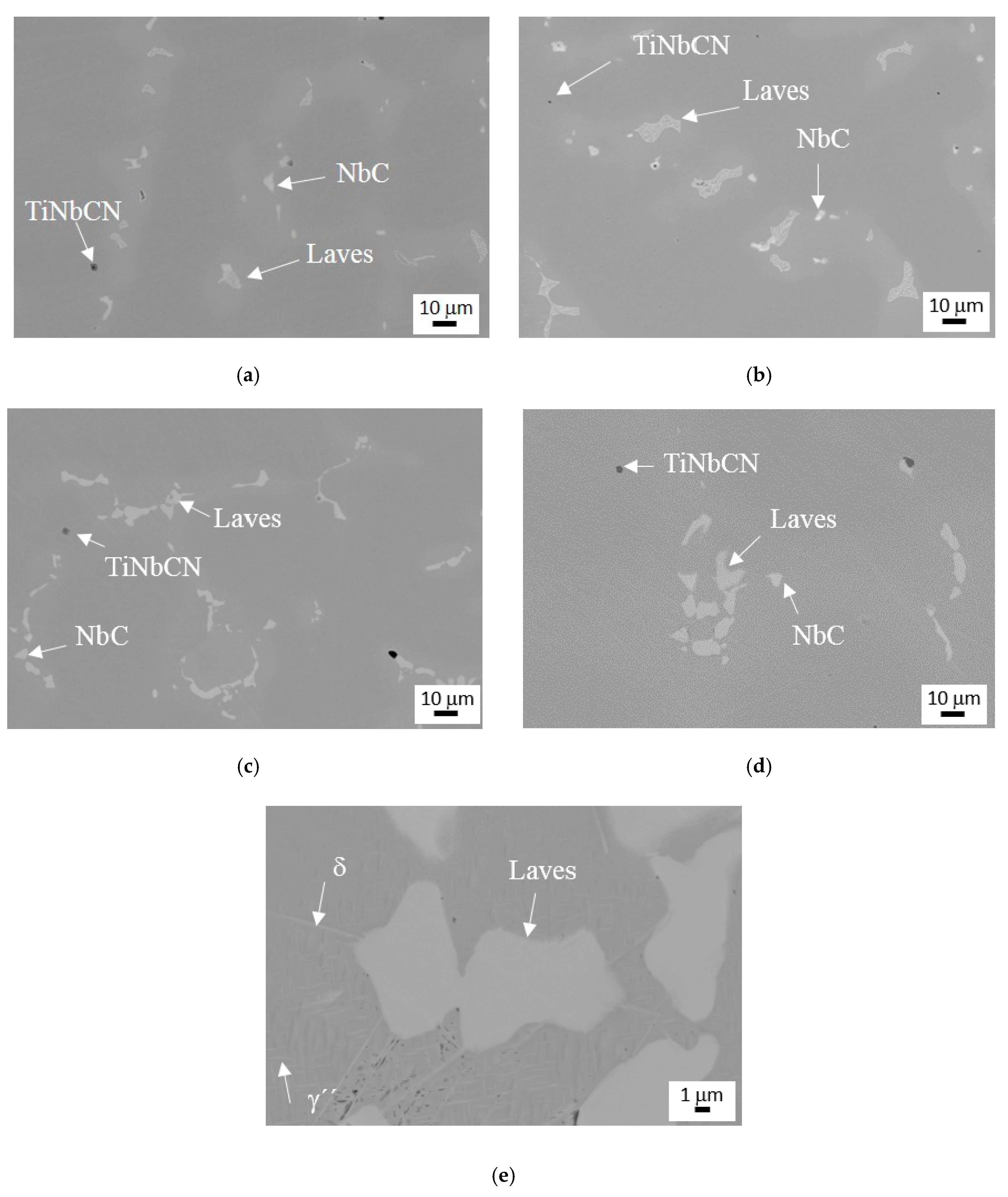




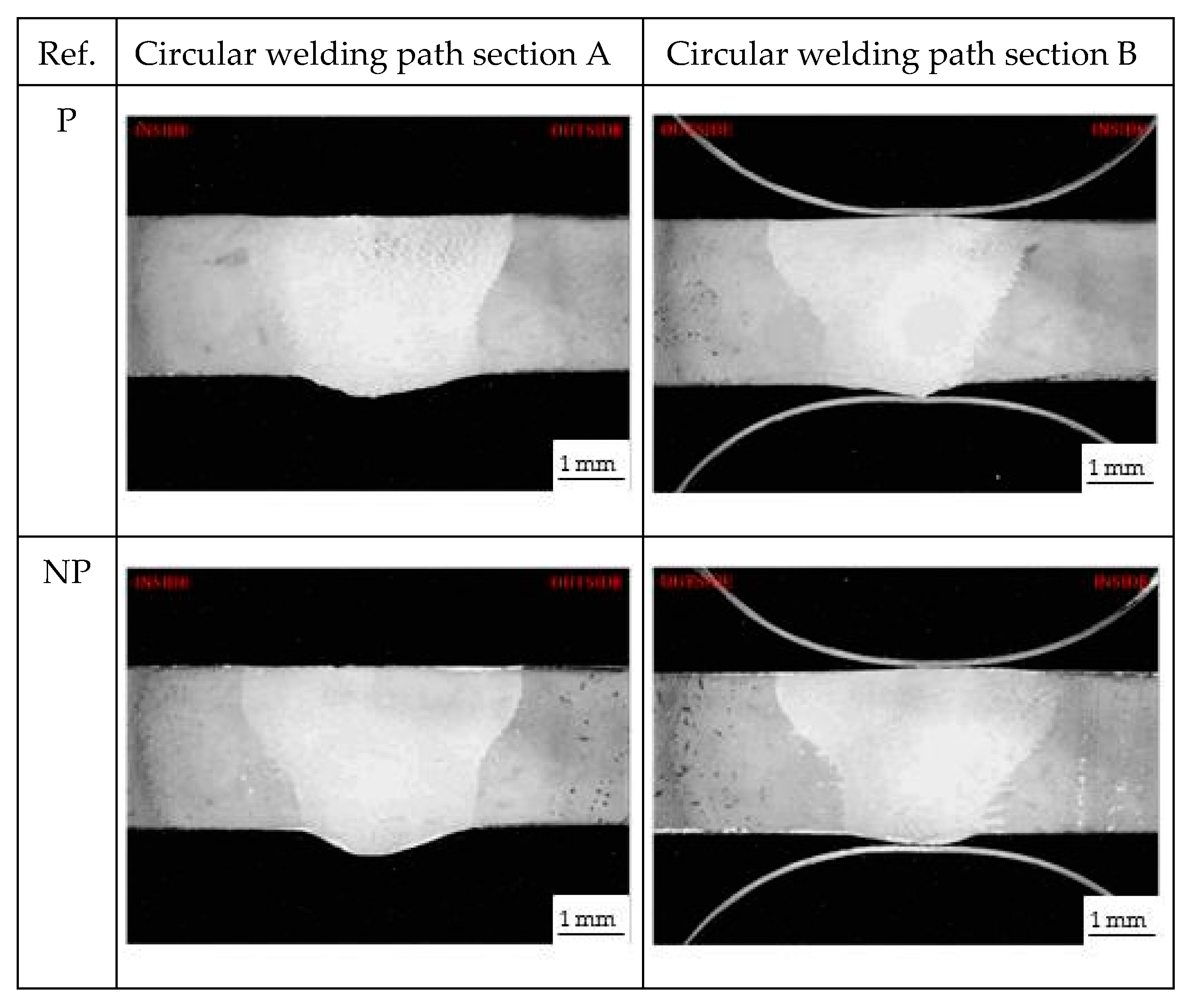

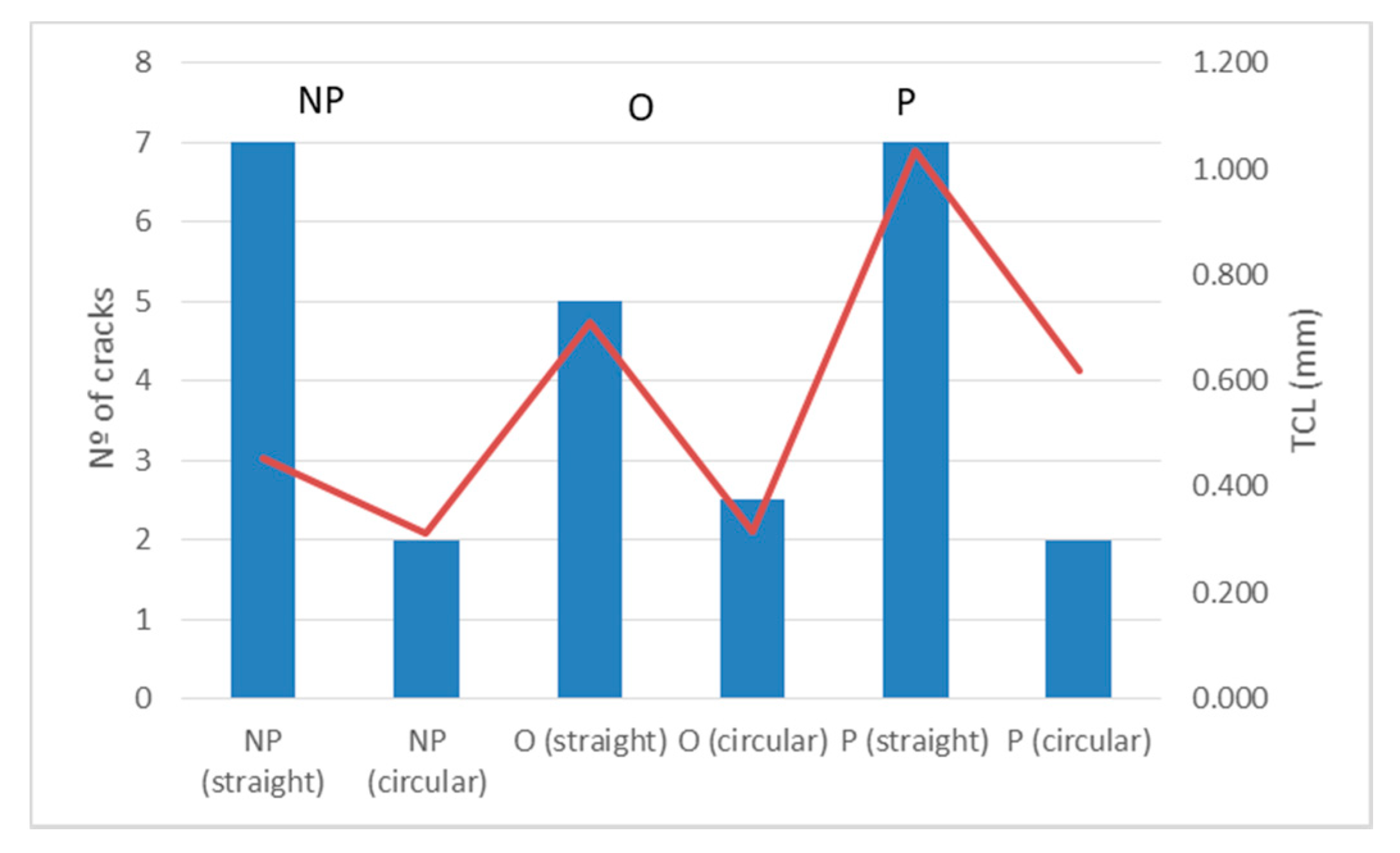

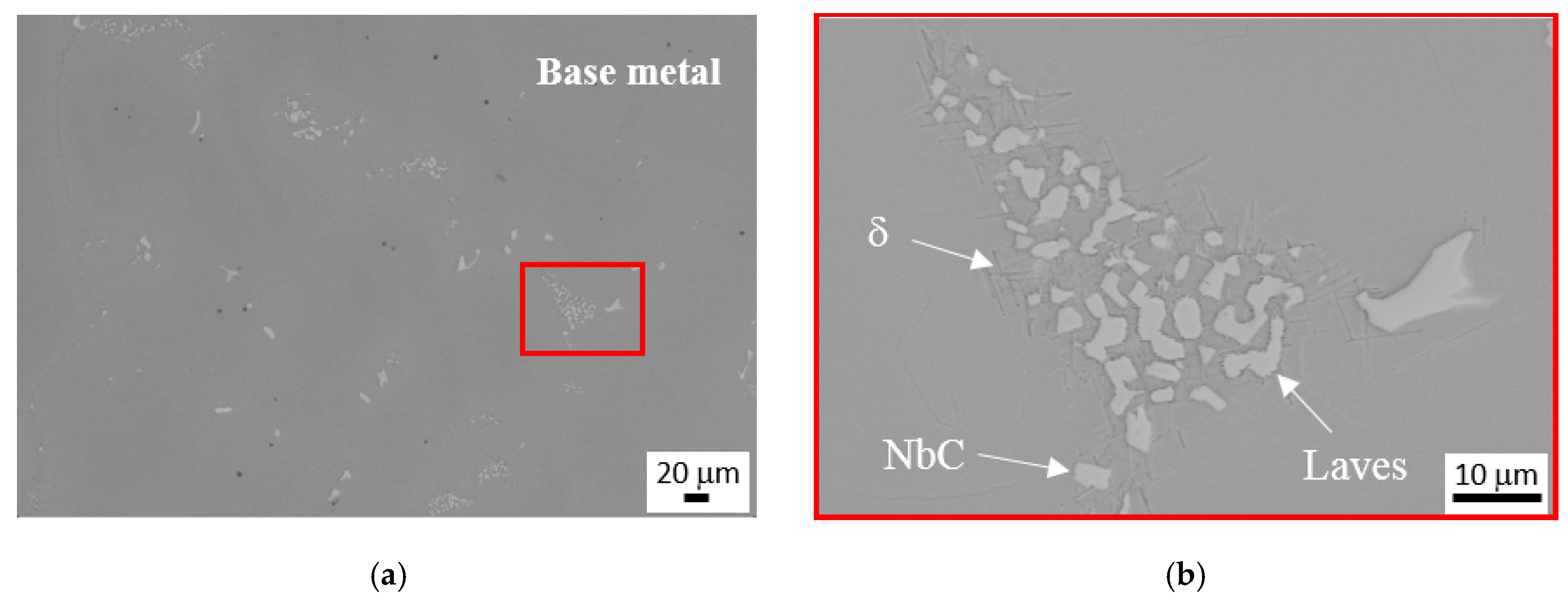
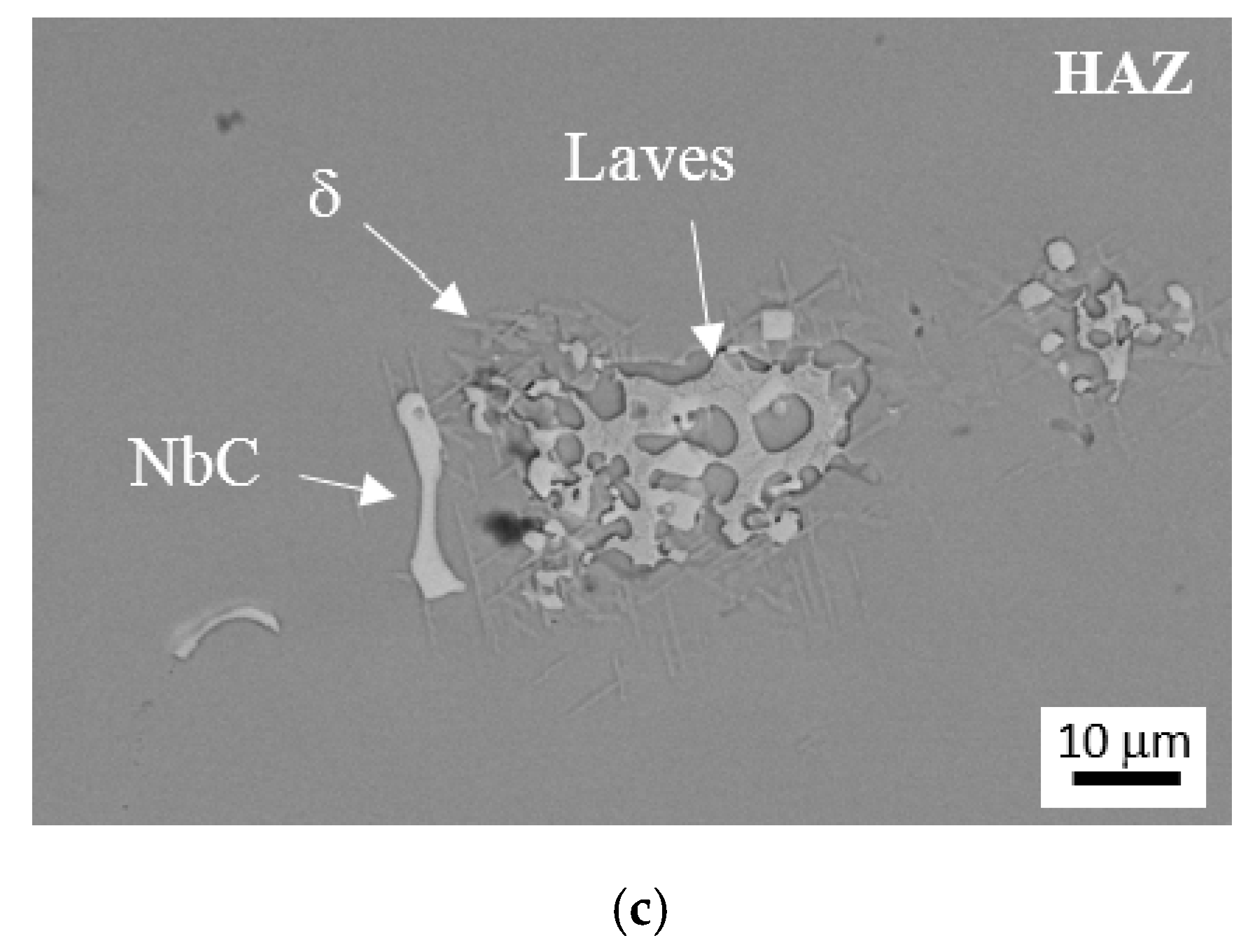
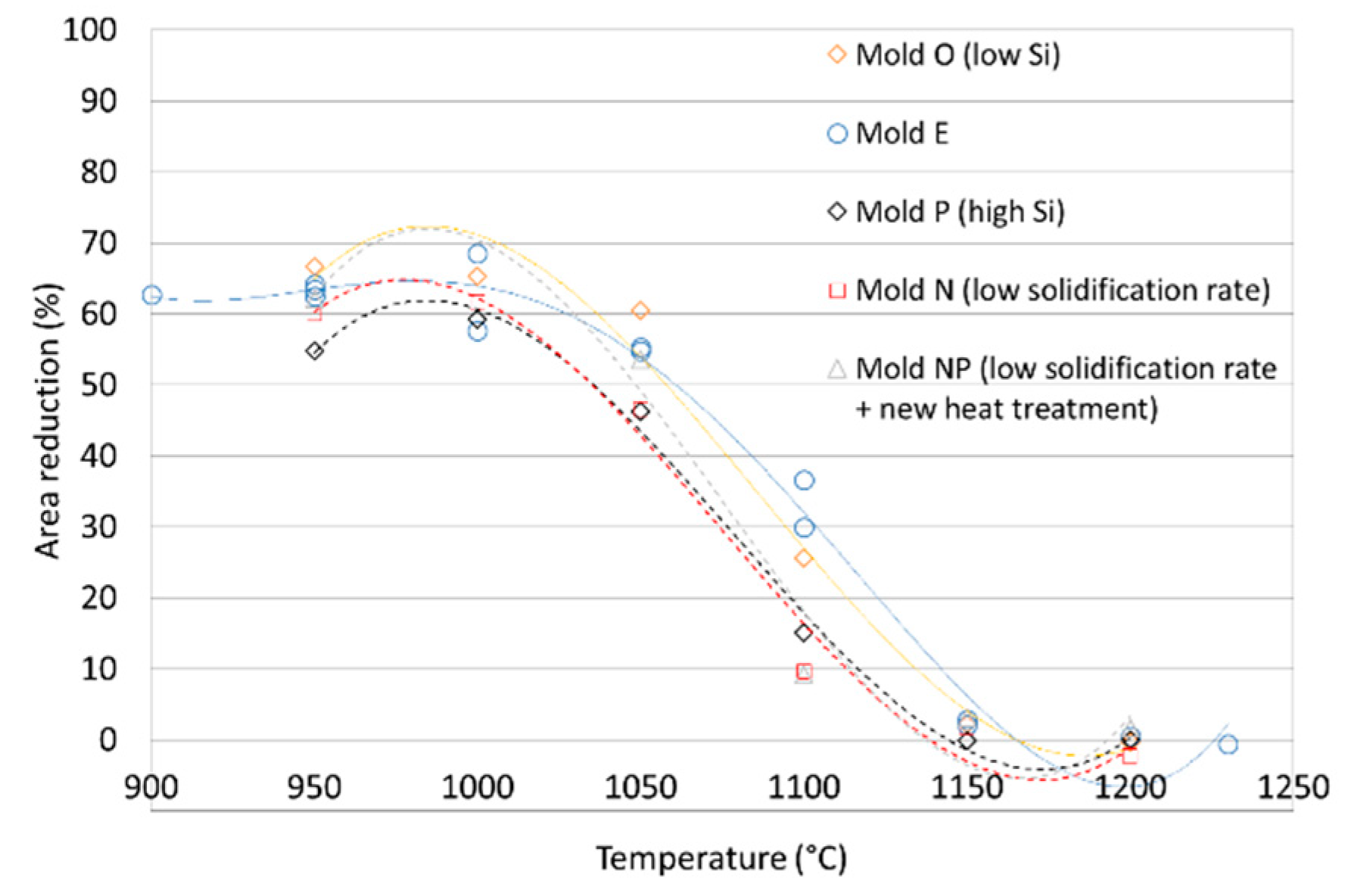
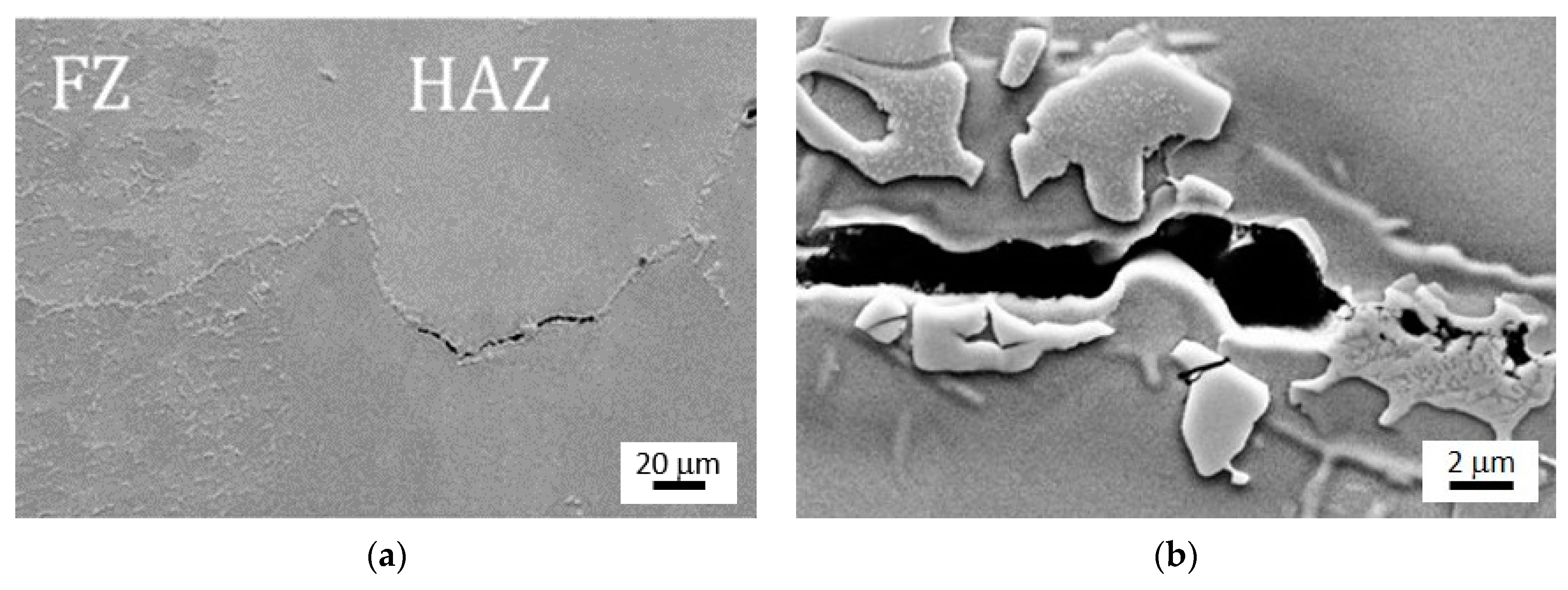
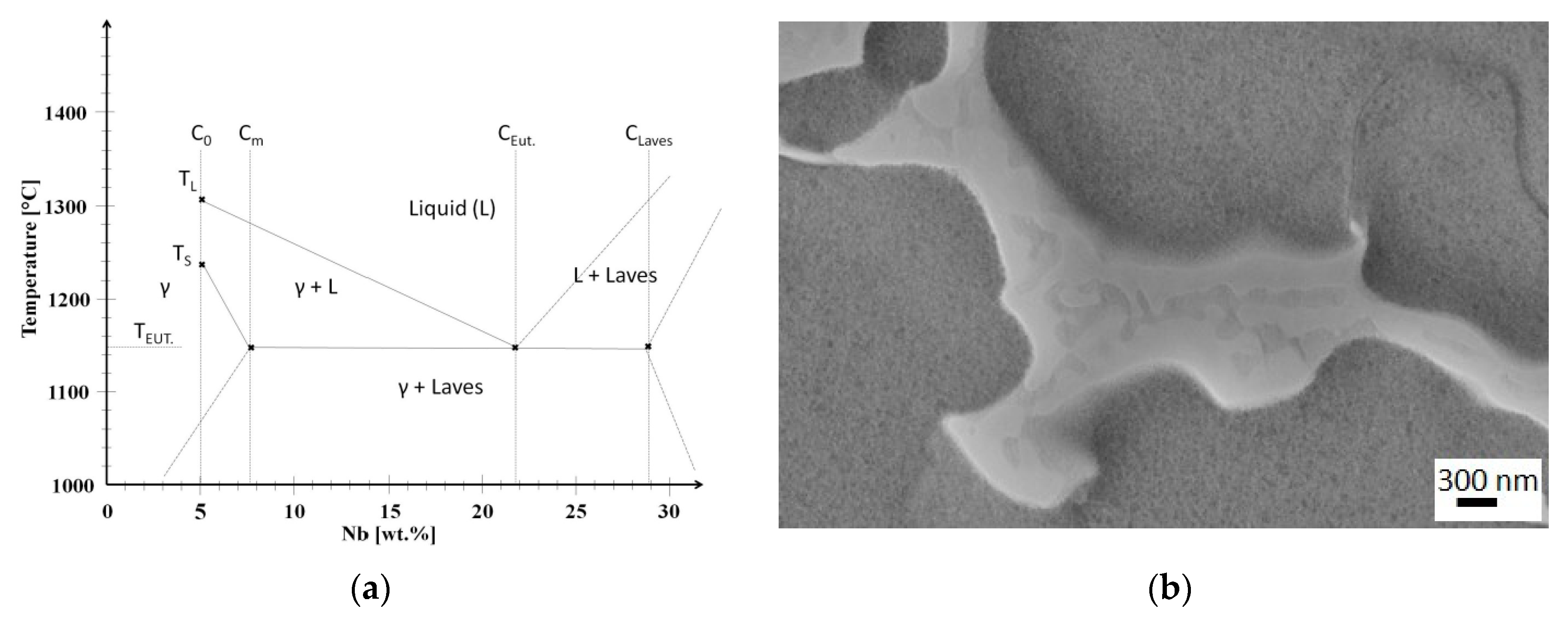
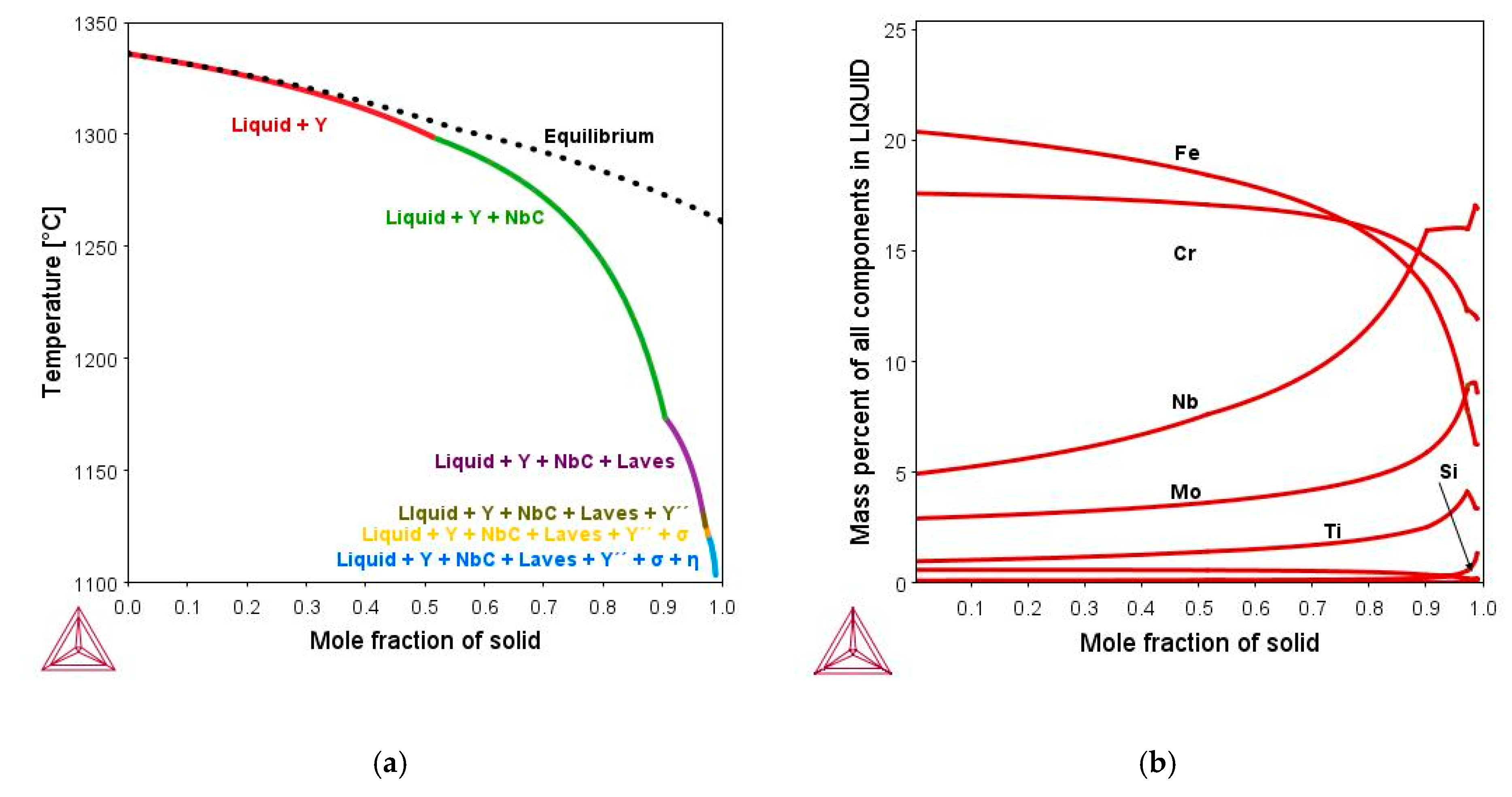
| Ref. | Ni | C | Si | Mn | P | S | Fe | Cr | Mo | Ti | Al | Nb + Ta |
|---|---|---|---|---|---|---|---|---|---|---|---|---|
| O | 51.9 | 0.047 | 0.051 | <0.050 | <0.010 | <0.005 | 21.1 | 17.8 | 3.02 | 0.89 | 0.47 | 4.75 |
| E | 52.1 | 0.049 | 0.11 | 0.037 | <0.010 | <0.005 | 20.4 | 17.6 | 2.91 | 0.98 | 0.59 | 4.92 |
| P | 51.7 | 0.038 | 0.17 | <0.050 | <0.010 | <0.005 | 21.1 | 17.7 | 3.02 | 0.89 | 0.46 | 4.85 |
| N/NP | 52.5 | 0.058 | 0.12 | 0.038 | <0.010 | <0.005 | 20.3 | 17.7 | 2.88 | 0.77 | 0.47 | 4.88 |
| Mould | State | Area % Laves | Al | Si | Ti | Cr | Fe | Ni | Nb | Mo |
|---|---|---|---|---|---|---|---|---|---|---|
| O | As-cast | 2.20 | 0.13 ± 0.05 | 0.28 ± 0.06 | 0.91 ± 0.07 | 11.86 ± 0.05 | 11.98 ± 0.24 | 34.02 ± 0.64 | 33.90 ± 0.50 | 7.67 ± 0.50 |
| HIP + S * | 0 | - | - | - | - | - | - | - | - | |
| E | As-cast | 2.40 | 0.15 ± 0.03 | 0.78 ± 0.09 | 1.02 ± 0.06 | 11.57 ± 0.46 | 11.63 ± 0.40 | 34.94 ± 0.48 | 32.49 ± 0.79 | 7.42 ± 0.38 |
| HIP + S * | 0 | - | - | - | - | - | - | - | - | |
| P | As-cast | 3.50 | 0.13 ± 0.05 | 1.29 ± 0.08 | 0.95 ± 0.05 | 11.15 ± 0.41 | 11.95 ± 0.36 | 34.63 ± 0.43 | 32.11 ± 0.70 | 7.80 ± 0.34 |
| HIP + S | 0.35 | 0.08 ± 0.06 | 2.02 ± 0.07 | 0.59 ± 0.09 | 11.43 ± 0.07 | 12.82 ± 0.24 | 29.76 ± 0.33 | 30.90 ± 0.76 | 12.39 ± 0.53 | |
| N | As-cast | 2.60 | 0.17 ± 0.02 | 0.91 ± 0.11 | 0.81 ± 0.08 | 11.19 ± 0.21 | 11.10 ± 0.21 | 34.54 ± 0.26 | 33.94 ± 0.35 | 7.40 ± 0.16 |
| HIP + S | 0.19 | 0.09 ± 0.06 | 1.71 ± 0.07 | 0.52 ± 0.11 | 11.48 ± 0.24 | 11.89 ± 0.24 | 30.15 ± 0.037 | 30.85 ± 0.38 | 13.99 ± 0.69 | |
| NP | Pre-HIP | 2.10 | 0.17 ± 0.06 | 1.19 ± 0.12 | 0.67 ± 0.14 | 10.90 ± 0.70 | 11.29 ± 0.39 | 32.59 ± 0.55 | 34.10 ± 0.97 | 9.09 ± 0.49 |
| Pre-HIP + HIP + S | 0.14 | 0.16 ± 0.05 | 1.76 ± 0.11 | 0.53 ± 0.05 | 10.98 ± 0. 30 | 11.83 ± 0.20 | 30.97 ± 0.71 | 31.28 ± 0.88 | 12.62 ± 0.93 |
| Mould | Ti | Nb | Mo | Fe | Cr |
|---|---|---|---|---|---|
| O | 2.28 | 3.70 | 1.49 | 0.76 | 0.86 |
| E | 2.37 | 3.75 | 1.25 | 0.79 | 0.85 |
| P | 2.57 | 3.95 | 1.40 | 0.78 | 0.88 |
| N | 2.04 | 2.73 | 1.37 | 0.78 | 0.82 |
| Mould | Mean Width (mm) | Mean Length (mm) | Aspect Ratio | Morphology |
|---|---|---|---|---|
| O | 1.1 ± 0.35 | 3.4 ± 0.92 | 3.1 | Columnar |
| E | 1.0 ± 0.46 | 3.2 ± 0.97 | 3.2 | Columnar |
| P | 1.1 ± 0.33 | 3.3 ± 0.78 | 3.0 | Columnar |
| N/NP | 2.1 ± 0.34 | 3.4 ± 0.71 | 1.5 | Coarse, slightly columnar |
| Mould | Ti | Nb | Mo | Fe | Cr |
|---|---|---|---|---|---|
| O | 1.29 | 1.37 | 1.28 | 0.89 | 0.93 |
| E | 1.27 | 1.16 | 1.32 | 0.94 | 0.95 |
| P | 1.20 | 1.34 | 1.28 | 0.93 | 0.94 |
| N | 1.13 | 1.52 | 1.52 | 0.98 | 0.99 |
| NP | 1.33 | 1.35 | 1.23 | 0.92 | 0.94 |
| Mould | Peak Temperature (°C) | DRT (°C) | BTR (°C) | Max. Ductility after Cooling | Ductility Recovery Rate |
|---|---|---|---|---|---|
| O | 1195 | 1150 | 45 | 64% at 1100 °C | Very fast |
| E | 1195 | 1145 | 50 | 69% at 1050 °C | Fast |
| P | 1195 | 1090 | 105 | 46% at 1000 °C | Intermediate |
| N | 1195 | 1110 | 85 | 14% at 1000 °C | Very low |
| NP | 1195 | 1110 | 85 | 24% at 1050 °C | Very low |
| Mould | Location | Area % Laves | Al | Si | Ti | Cr | Fe | Ni | Nb | Mo |
|---|---|---|---|---|---|---|---|---|---|---|
| 9 mm | ||||||||||
| O | FZ | 1.78 | 0.41 | 0.22 | 1.51 | 14.02 | 14.80 | 43.52 | 20.53 | 4.99 |
| HAZ/BM | - | - | - | - | - | - | - | - | - | |
| P | FZ | 4.13 | 0.40 | 0.65 | 1.68 | 13.44 | 14.19 | 44.12 | 20.51 | 5.02 |
| HAZ/BM | 0.20 | - | 1.98 | 0.53 | 11.16 | 12.55 | 30.70 | 30.33 | 12.74 | |
| NP | FZ | 2.41 | 0.56 | 0.47 | 1.57 | 13.53 | 13.42 | 43.65 | 22.11 | 4.68 |
| HAZ/BM | 0.32 | - | 1.55 | 0.57 | 11.64 | 12.24 | 31.20 | 29.14 | 13.66 | |
| Less than 3.0 mm plate | ||||||||||
| P | FZ | 2.63 | 0.51 | 0.33 | 1.36 | 14.34 | 15.17 | 43.29 | 20.17 | 4.82 |
| HAZ/BM | 0.20 | 0.14 | 2.01 | 0.5 | 10.96 | 12.43 | 30. 92 | 30.42 | 12.58 | |
| NP | FZ | 1.50 | 0.48 | 0.49 | 1.46 | 13.61 | 13.88 | 43.07 | 22.07 | 4.94 |
| HAZ/BM | 0.30 | 0.40 | 1.43 | 0.81 | 11.94 | 12.03 | 35.76 | 26.73 | 11.17 | |
| Laves Phase | Al | Si | Ti | Cr | Fe | Ni | Nb | Mo |
|---|---|---|---|---|---|---|---|---|
| Crack-HAZ | 0.83 | 0.73 | 1.45 | 12.93 | 12.94 | 42.36 | 23.68 | 5.08 |
| FZ | 0.40 | 0.65 | 1.68 | 13.44 | 14.19 | 44.12 | 20.51 | 5.02 |
| HAZ | - | 1.98 | 0.53 | 11.16 | 12.55 | 30.70 | 30.33 | 12.74 |
| Element | Q (kJ/mol) | Do (m2/s) | D1050 °C (m2/s) | D1100 °C (m2/s) | D1150 °C (m2/s) | Reference |
|---|---|---|---|---|---|---|
| Nb | 202 | 1.0 × 10−6 | 1.1 × 10−14 | 2.1 × 10−14 | 4.0 × 10−14 | [29] |
| Ti | 257 | 86 × 10−6 | 0.6 × 10−14 | 1.4 × 10−14 | 3.2 × 10−14 | [30] |
| Mo | 288 | 300 × 10−6 | 0.1 × 10−14 | 0.8 × 10−14 | 0.8 × 10−14 | [31] |
| Ref. | Si in Alloy (wt %) | Si in Laves (wt %) | Laves wt % | Equilibrium Simulation | Scheil Simulation | ||||
|---|---|---|---|---|---|---|---|---|---|
| Tsol (°C) | Tliq (°C) | ΔT (°C) | Tsol (°C) | Tliq (°C) | ΔT (°C) | ||||
| O | 0.051 | 0.03 | 1.71 | 1213.6 | 1339.8 | 126.2 | 1110.1 | 1339.8 | 229.8 |
| E | 0.110 | 0.13 | 1.78 | 1212.0 | 1335.8 | 123.8 | 1103.5 | 1335.8 | 232.4 |
| P | 0.170 | 0.43 | 1.91 | 1209.2 | 1338.0 | 128.8 | 1084.0 | 1338.0 | 254.1 |
Publisher’s Note: MDPI stays neutral with regard to jurisdictional claims in published maps and institutional affiliations. |
© 2021 by the authors. Licensee MDPI, Basel, Switzerland. This article is an open access article distributed under the terms and conditions of the Creative Commons Attribution (CC BY) license (http://creativecommons.org/licenses/by/4.0/).
Share and Cite
Álvarez, P.; Cobos, A.; Vázquez, L.; Ruiz, N.; Rodríguez, P.P.; Magaña, A.; Niklas, A.; Santos, F. Weldability Evaluation of Alloy 718 Investment Castings with Different Si Contents and Thermal Stories and Hot Cracking Mechanism in Their Laser Beam Welds. Metals 2021, 11, 402. https://doi.org/10.3390/met11030402
Álvarez P, Cobos A, Vázquez L, Ruiz N, Rodríguez PP, Magaña A, Niklas A, Santos F. Weldability Evaluation of Alloy 718 Investment Castings with Different Si Contents and Thermal Stories and Hot Cracking Mechanism in Their Laser Beam Welds. Metals. 2021; 11(3):402. https://doi.org/10.3390/met11030402
Chicago/Turabian StyleÁlvarez, Pedro, Alberto Cobos, Lexuri Vázquez, Noelia Ruiz, Pedro Pablo Rodríguez, Ana Magaña, Andrea Niklas, and Fernando Santos. 2021. "Weldability Evaluation of Alloy 718 Investment Castings with Different Si Contents and Thermal Stories and Hot Cracking Mechanism in Their Laser Beam Welds" Metals 11, no. 3: 402. https://doi.org/10.3390/met11030402







